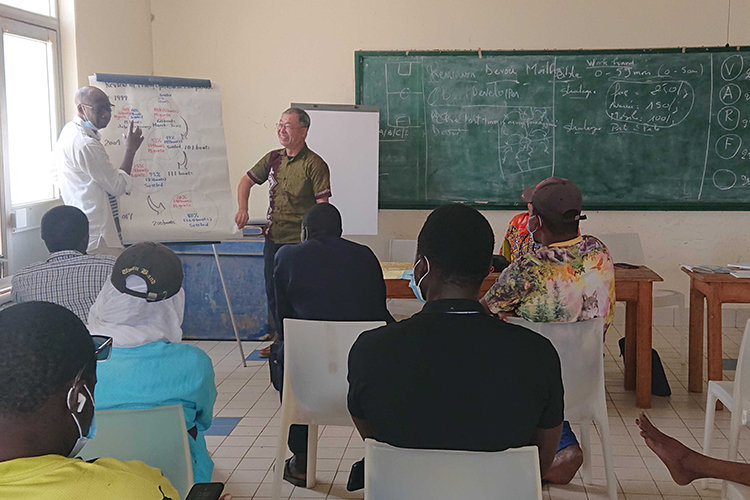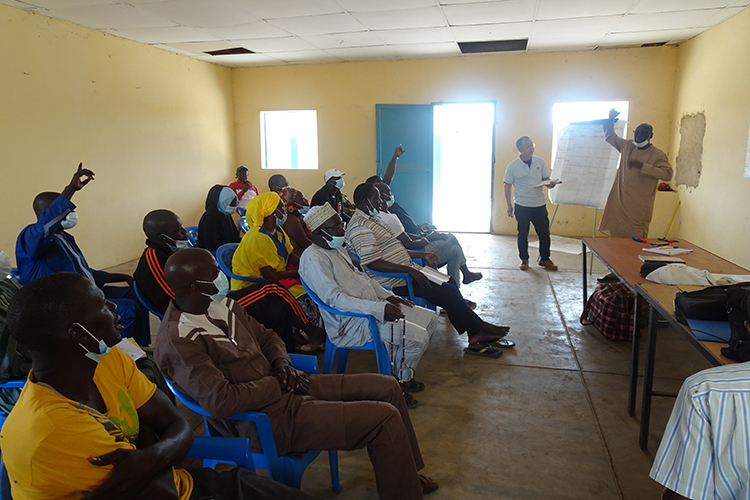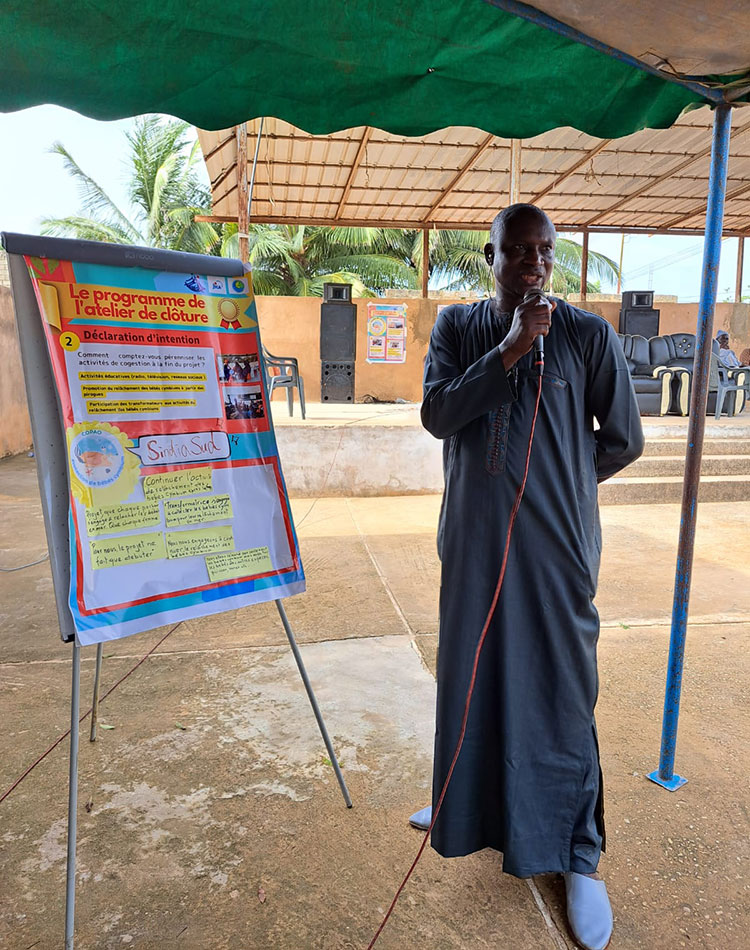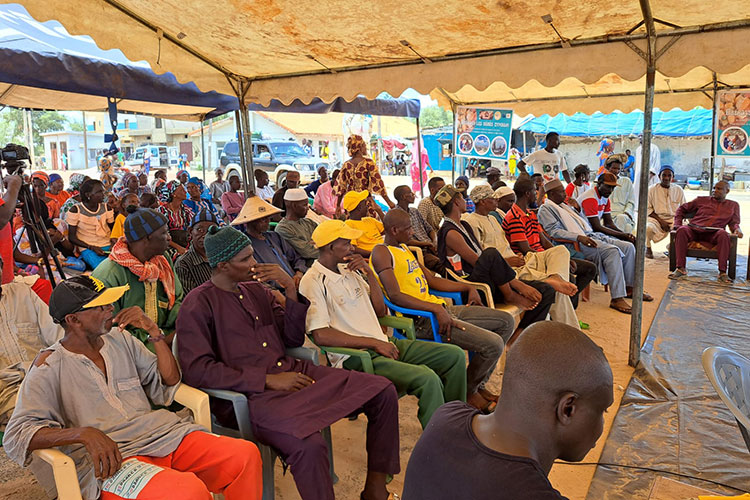1.1 Identification of resource management challenges
This is the process by which Fisheries Directorate extension officers, fisheries local officers (regional, departmental, and post chiefs), donors, and others taking part in promoting co-management of fisheries resources involve community leaders and various fisheries-related leaders to understand the current situation and challenges related to resource management and to share such information among stakeholders.
- Initiate resource management activities
- Select sites for activities
- Identify challenges
- Share the challenges identified with stakeholders
Initiate resource management activities
In the present world where sustainable resource use and environmental issues are being discussed globally, management activities to promote the sustainable use of fishery resources are necessary. However, when starting resource management activities, is it better to start activities as an administrative task or start activities to resolve existing issues? There may be various triggers for activities, depending on the situation.
Regardless of the situation, when activities are started in a specific area and the current status of resource use becomes clear, various issues and activities required to overcome these issues emerge. Therefore, the first step in resource management activities is to clarify the challenges and share them among stakeholders.
1. What to do if the problem has already occurred?
When implementing resource management activities in a specific area, there may be phenomena such as conflicts between fishermen on the fishing grounds, frequent illegal operations by migrant fishermen, or difficult management of fishermen's households due to the decrease in size or reduction of the target resources. In such cases, a place for discussion among community residents and fishery stakeholders in the target area should be set up to clarify the causes. There is not always a single cause but often a combination of factors. Furthermore, there are often differences in interpretation of the phenomenon depending on the position of the speaker. Therefore, a wide range of information sources is needed to understand the context and factors behind the phenomena. Organising workshops with a variety of stakeholders can be an effective way of understanding the situation. Sharing the perceptions gained through such activities among the parties involved is an important step in resource management activities.
Select sites for activities
Choosing the first village in a target area for resource management is important for the subsequent dissemination of resource management activities; the success or failure of activities in the first village will have a significant impact on the subsequent extension of resource management activities. As the activities progress, information on them is disseminated to the surrounding communities. If the activities are well received, the number of interested people in the surrounding communities will increase, and the target area for activities will gradually expand. The initial selection of activity sites has a considerable impact on subsequent dissemination.
Individuals, groups, institutions, and organisations that take the lead in resource management, such as fisheries managers, local government officials, and donors, should consider the following selection criteria when choosing sites for their activities:
- ・Local people have a strong sense of urgency to address existing problems, such as conflicts among fishermen, decreasing resources, and tight management of fishing households.
- ・The leadership of fishermen and other communities is strong.
- ・The number of fishermen, types of fishing, and species caught are relatively limited, and the fishing method is relatively simple.
- ・Administrative offices are easily accessible and not too far away.
1. Criteria for selecting target fishing villages to start the resource management activity
How to select the village (community) to start the first activity of community-led fisheries resource co-management? In the assessment and management planning study on fisheries resource management conducted by JICA from 2003 to 2006, the criteria for selecting the first target fishing villages for the pilot project were as follows: (1) fishers’ resource management awareness, (2) cohesion of existing fishers' organisations, (3) composition of target resources, (4) size of fishing villages, and (5) access to markets.
Identify challenges
What method can be used to identify potential challenges that are not yet clear and to understand the context and causes of problems that have already occurred? Two alternatives exist to address this: one is to organise a workshop in which all stakeholders come together and share their ideas and experiences; and the other involves conducting a survey using various techniques to identify challenges.
⑴ Workshop method
To understand challenges, stakeholders such as fishers, (female) processors, and fisheries administrators come together for a participatory workshop to discuss the problems in the implementation of resource management activities, the factors and people involved in these problems, and solutions to implement. One way to conduct a workshop is to use the Project Cycle Management (PCM) method, which includes stakeholder analysis to identify the people involved and problem analysis to develop a problem tree.


1. Stakeholder analysis, problem analysis, and objective analysis of the PCM method
Stakeholder analysis
There are a variety of stakeholders in the local fishing industry, including fishermen, villagers, distributors, processors, and fishers from surrounding villages. As their relationships are often complex, the characteristics of the stakeholders and their relationships will be organized with mapping based on the opinions of the workshop participants. The information obtained from the preliminary survey is often useful for the workshop facilitator to[1] understand the thinking of the stakeholders on the ground and to steer the workshop in the right direction.
Problem analysis and objective analysis
Workshop participants are asked to write down the problems of fisheries resources and fisheries around the target site. Then, the relationships between the problems are put in order by all participants (problem analysis).
The solved states of each problem identified are written down and put in order (goal analysis). It is a method of finding solutions to large and complex problems by breaking them down and simplifying them.
⑵ Survey method
There are two types of surveys: desktop and field. In a desktop survey, information on such items as the population, number of fishermen, and fishing statistics of the target area is collected by checking available data with relevant authorities. If several years of data are available, tables and graphs can be drawn to understand changes over time. A field survey is an opportunity to collect data and information that cannot be obtained without visiting the site. These include group interviews, participatory rural appraisal (PRA), rapid rural appraisal (RRA), questionnaire surveys, and field assessments, depending on the situation and information required.
2. Information that is needed in a survey
To understand the challenges of fisheries resource activities, it is necessary to understand the socio-economic situation in the target area in addition to fishing activities. For example, if the issue is that ‘it is becoming harder for fishermen to earn a living’, the survey will not only include a fisheries survey to determine the amount and value of fish catches from the past to the present but sections to determine the socioeconomic situation, such as price fluctuations and changes in the cost of living of fishermen. By combining the results, the survey could help to identify the challenge of family fisheries management and analyse the factors behind it. The table below shows a few examples of information that will be obtained from fishery and socio-economic surveys.
| Socio-economic conditions | Fishing conditions | ||
| Social conditions | Economic conditions | Fishing activities | Resource management activities |
| ・Demographic composition ・Family composition ・Social infrastructure (transport, communication, school, hospital) | ・Household income/expenditure ・Livelihoods ・Composition of income and distribution | ・Target species ・Fishing methods ・Fishing period ・Quantity of fish catch ・Market price ・Fishing infrastructure ・Distribution channels | ・Functions of fishermen's organisations ・Relation with administrations ・Resource management initiatives (marine protected area (MPA) management. fish size management, no-fishing area, no-fishing season) ・Surveillance and monitoring |
3. Procedure of a field survey
a) Before starting a survey, the purpose of the survey should be explained to key stakeholders such as local government offices, village elders, and fishermen's leaders, and their cooperation should be requested. Then, sources of information that are not available through a desk-top survey or that can only be obtained locally should be identified. It is important to confirm the survey content and schedule in consultation with fishermen leaders and request the selection of group interview participants.
b) Survey methods can be questionnaire-based or participatory. A questionnaire-based survey is generally used to collect data according to statistical analysis and analyse them. In a participatory survey, target people are selected according to its content, and issues in the field are identified while exchanging opinions with the target group.
c) Depending on the purpose and context of the survey, one survey method or a combination of survey methods is chosen. Participatory surveys that include a flexible choice of survey tools are often appropriate for the following reasons: West African fishing villages have a wide variety of ethnic groups and diverse fishing-related occupations such as fishing boat owners and crews, and female processors.
d) The participatory rural appraisal (PRA) method and Rapid Rural Appraisal participatory rural research (RRA) method are social survey methods. Both are defined by the level of participation of local stakeholders and the purpose of the survey and are useful basic tools in field surveys.
2. Comparison of participatory and questionnaire surveys
Participatory survey (PRA, RRA) Questionnaire survey Duration Short (at least a few days) Long (up to 1 year) Role of local stakeholders Participation as a partner in the field survey (active participation) Response to the questionnaire as target people (passive participation) Survey method Semi-structured interview, visual tools (such as calendar and map) Data collection and interview using a questionnaire Sampling method Selection of target persons according to the purpose of the survey Random sampling based on statistics Analysis procedure Analysis and confirmation through discussions with stakeholders at the survey site Analysis by the survey team after collecting the result of questionnaire
2. Identifying the issues of resource management through questionnaire survey
At the beginning of activities, it is important to understand the current awareness, needs, and issues of the target fisheries stakeholders on resource management, to facilitate coordination of interests and subsequent consensus building for the stakeholders. Surveys of residents’ awareness are an effective means of achieving this. In the JICA COGEPAS project, which started in 2009, a baseline survey before the start of the project and an end-line survey at the end of the project were conducted. Additionally, a questionnaire survey was implemented to understand the knowledge, experience, and initiative of the target fishermen regarding fisheries resource management.
Share the challenges identified with stakeholders
When conducting the survey, its purpose should be explained to local people to encourage their active participation in the implementation phase. The results of the survey should be reviewed and analysed and information sessions should be organised for survey participants. Fostering a sense of ownership among local stakeholders in resource management activities from the beginning is critical for the efficient implementation of subsequent resource management activities.


3. Sharing the results of the participatory survey with stakeholders
The divers of CLPA Dakar Ouest and others requested JICA for assistance to conduct resource management activities as both the size of abalone collected and the amount harvested have been decreasing in recent years. In response, COPAO, a JICA project, together with the Directorate of Maritime Fisheries staff, has held discussions with key members of the said CLPA since May 2022. To ascertain the resource status of abalone, the dimensions of the landed abalone were measured at several landing sites in cooperation with divers. It was found that 26% of the abalone were landed with shell lengths of 45 mm or less, and 51% with shell lengths of 50 mm or less, and the results were shared with members of the CLPA.
1. Initially, the workshop will be facilitated by someone from the lead government, donor, or NGO who wishes to initiate resource management activities. However, it is better to gradually hand it over to a field officer.